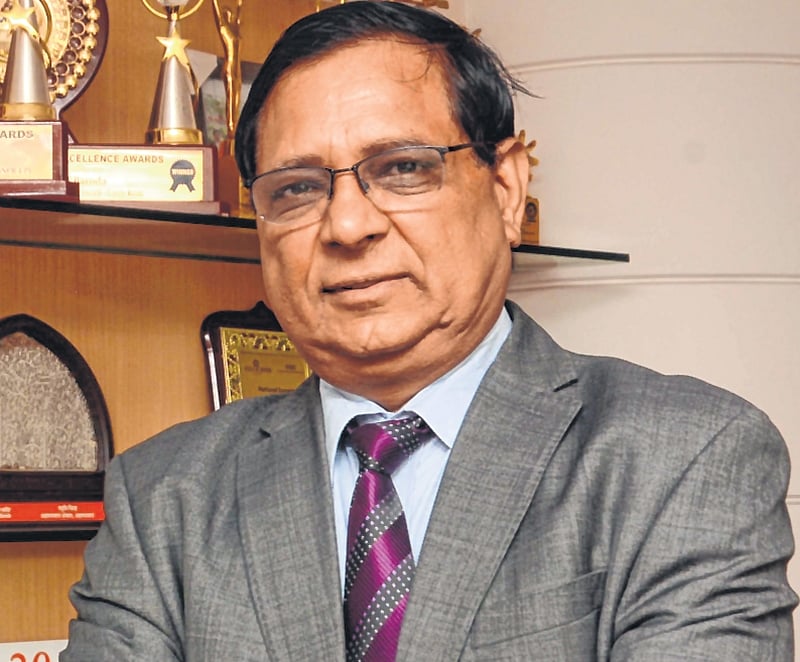Bank of Baroda has been in the limelight for a lot of reasons—not just for its big moves but also for its small, regular services. The bank has been quite active in the past one year as far as the SME segment is concerned. From the best implementation of the ‘loan in 59 minutes’ concept, to being among the best banks in Mudra disbursements, the focus on small borrowers comes through. K P Singh, Head MSME Relationships, talks about the sector and the bank's approach with Pankaj Joshi.
Edited Excerpts:
How would you profile the SME business of Bank of Baroda and how would it change once the proposed amalgamation of other banks comes into effect?
The recently announced merger will enhance the importance of the MSME business in the bank. On standalone basis, Bank of Baroda had a global book of around Rs 4.68 lakh crore (pre-merger), wherein the SME business was around Rs 55,000 crore.
Post-amalgamation, the total book is expected to go to Rs 6.25 lakh crore, wherein the SME share would be in the region of Rs 94,000 crore. So, post-amalgamation share of the SME segment goes up from 12 per cent to 15 per cent.
Bank of Baroda is a bank with pan-India presence, and same is the case with our SME book. Zone wise, the major contributors are Gujarat (around 20 per cent), Mumbai (12 per cent), Rajasthan (10 per cent) and Delhi (9 per cent). These four zones account for more than half of the book.
Industry wise, we are agnostic, though we do have seven-eight area-wise schemes for specific industries. In the last five-seven years, we have seen good demand coming from pharma, engineering and chemicals.
Steel and ship breaking, cyclical in nature, were down and have started picking up recently. There is a decline in gems and jewellery as well as real estate. Textiles on the whole has been steady for us.
What processes are followed by the bank across the country in the SME segment?
Presently our operations are done through 40 SME loan factories and two Integrated SME Loan Factories (ISMELFs) across the country. The new concept of ISMELF covers all processes—sourcing, documentation, scrutiny, sanctions, monitoring, and disbursements.
Our bank is listed on all the three trade platforms covered by the RBI. This is a massive advantage because we not only cover the basic borrower's transactions, but those of his clients and vendors as well. We can cover amounts as small as Mudra loans and reach up to Tier-III cities. It effectively means we are ring-fencing the loan.
In the last couple of years, we have modified our strategy. We have moved from balance sheet based lending to cash flow based lending. Second modification is that we are moving beyond walk-in business to active sourcing, targeting specific industries and sometimes locations as well.
Last year we have started a unique product, wherein we link rate of interest with the CIBIL-CMR ranking. The higher the ranking, better are the terms for the borrowers.
Today the best-rated companies get funds at MCLR plus 0.05 percent, which currently comes to 8.75 percent. The net result of all these innovations is that while SME business of the banking sector grew at seven-eight per cent last year, we saw around 16 per cent growth.
Another innovation is co-lending with Non-Banking Finance Companies (NBFCs) to those specific industries where they have a level of expertise and presence. SREI Finance, for instance, has a good presence in equipment financing.
To grow our book in this segment, we leveraged SREI Finance’s expertise in scrutiny and collection. The NBFC typically benefits because it can leverage its expertise, retain customers and also overcome liquidity issues. However the real benefit is to customers as they shall be getting the benefit in terms of pricing, which was very high with NBFCs.
The loan is shared between us in the 80:20 proportion. Another such NBFC is Edelweiss Group, which is active across industries, and wherein we get large-ticket loans (Rs 30 crore and above).
We can increase penetration in areas where we have limited reach and build on our relationship. We expect a book of Rs 2,000 crore in the first year (through separate partnership with SREI Finance and Edelweiss Group) which would become Rs 5,000-6,000 crore over three years.
Going forward, we want to increase export-based lending, where we already have a product in place. Cluster-based lending will also increase in future. We already have a practice of area-based schemes and now are actively looking at tie-ups with local agencies for getting information about each (target) cluster.
Looking at each cluster is important. Even the same industry shows different performance in different geographies, like textiles in Bhilwara and Tirupur behave in different way.
We believe that any industry doing well in any area also depends on external factors like state government’s approach and community support, apart from basic business factors. We have a good amount of data generated internally, and this, along with the other public available data, will play a vital role in our future activities.
How much do you think SME companies need to evolve in their mindset?
Quite a bit honestly. In my experience, SMEs have financial structures which are neither well planned nor well managed. Most of the time they search advisors who will optimise their tax.
More often than not, this means showing lower sales on the books. Once you do that, the credit availability is impacted, because working capital would be based on revenues.
So the business has to make do with lower working capital from banks, and then has to go and borrow from elsewhere including NBFCs at higher rates. The other mindset issue is that ownership and management are mostly not segregated.
That means the business is often run as an extension of the promoter’s own household, and the specific needs of the business are not prioritised.
Beyond the mindset issues, there is a knowledge gap among the SMEs which also hinders their growth. They must understand the importance of compliance in accessing credit to fuel their future growth plans.
For example, even if Goods and Services Tax (GST) compliance is improved on sustainable basis, we can evaluate the company in a better light and extend better support.
Are there other areas of attention in this context?
Definitely, SME is the segment which has maximum employment generation, and hence must be handled accordingly. If one is considering waivers and interest subvention for agriculture,
I am sure the same can be considered for this segment in case of natural calamity or there should be some product in insurance sector to insure these type of risks.
Besides that, tax holidays, better infrastructure support, helping them access technology, providing quick single-window clearance—all this will go a long way towards improving the mindset.
This is not confined to the Indian environment—a recent RBI document reveals that there are 267 separate definitions of the SME term across 154 countries. Just standardising that would help a lot in assessment and appraisals.
Another area of attention would be different appraisal and rating yardsticks for these companies. A small company cannot have the performance and financial stability ratios of an industry leader and it is not fair to judge them both on the same benchmark.
The small company invariably suffers and their credit costs go up. We have recently done away with Bank loan ratings for SMEs up to Rs 50 crore.
The SME entrepreneur puts in upfront investment, takes the risk, and has low bargaining power with large buyers. Despite all this, it generates jobs. SMEs are also vulnerable when large companies perform badly and then experience unhappiness when SMEs have to lay off people. Therefore a certain amount of sensitisation is needed while dealing with SMEs.
It is not a coincidence that NBFC’s share of SME credit has been increasing year on year, much higher than the overall share they have in the financial system.









